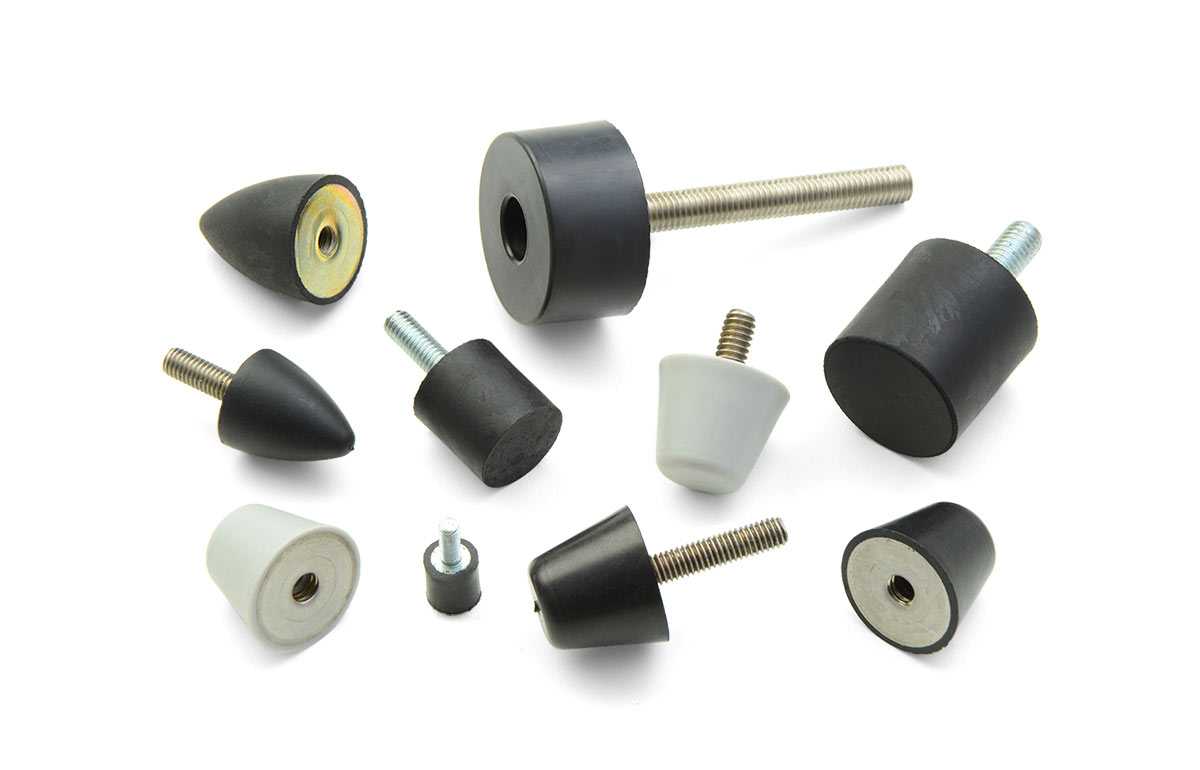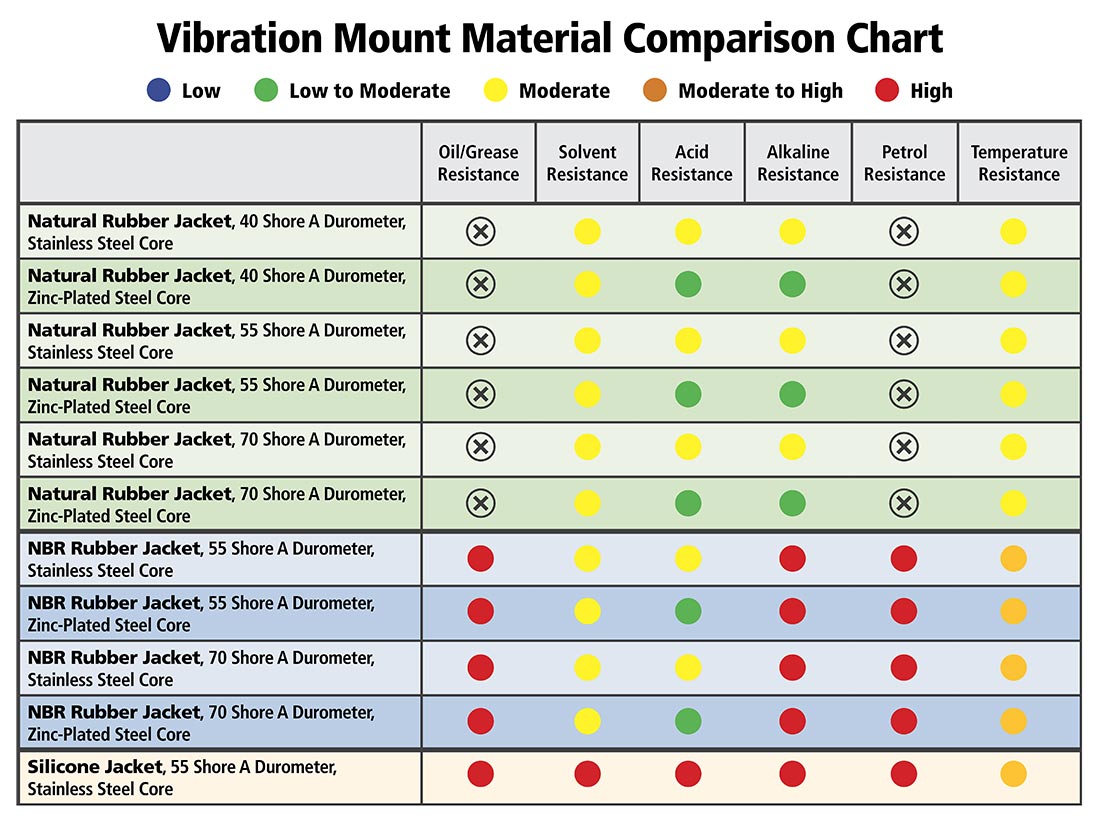7 Things To Consider Before Selecting A Vibration Mount

Every application is different, but there are common problems that affect all types of machinery and equipment across a variety of industries. Vibration, impact loads, and noise are likely to be important considerations in most environments, and a common way to mitigate these factors is by using and .
Vibration isolation mounts are made from a metal core and rubber jacket that reduce vibration and noise in a variety of machinery through the damping properties of the rubber. They attach to machines or surfaces with , , or depending on the application needs. Vibration isolation mounts are often sandwiched between two pieces of equipment to isolate their vibration. They are designed to prevent damage and noise to equipment and the surfaces they rest on by absorbing the kinetic energy generated during operation, extending life and creating a safer, quieter work environment.
Rubber bumpers are similar in design and function, however have either
or . They are a better choice for absorbing direct impact loads like machine doors or as safety buffers in automated machinery. They can also be used as feet to mitigate floor vibrations, elevate an assembly, and protect floors/equipment from damage. Rubber bumpers have a wider variety of material and shore hardness options allowing them to be used in a more diverse range of applications.Before you can select one of these components, however, you must consider all or some of the following factors.
1. How Will The Vibration Mount or Bumper Be Mounted?
These shock absorbing mounts are available with a single stud, two studs, a single tapped hole, two tapped holes, or a single stud and a single tapped hole, giving designers options in how they are mounted. If the component only needs to be mounted on one end, a rubber bumper is a better option and the designer must decide if the assembly is better supported by the tapped hole or threaded stud. Fortunately, there is no notable performance difference between these two mounting configurations as this is determined by the shore hardness, height, and material of the rubber jacket.

There are several different vibration mount configurations to match a variety of application needs.
Mounting a vibration isolation mount is more complicated than a rubber bumper since the user must mount them from either end. They are primarily used to connect two parts of a machine together. Sandwiched between two machine components or surfaces, they can effectively stabilize the assembly while also absorbing shock and vibration. It is important to consider that vibration mounts will experience wear over time and require replacement. Whether the machine itself is designed with studs or tapped holes or a combination of the two has implications over how it is initially assembled as well as how it is serviced with replacement vibration isolation mounts.
2. What Is The Expected Max Impact Load?
Unsurprisingly, vibration isolation mounts and rubber bumpers do not share identical damping or shock absorption properties. Dimensions and jacket material affect how these components perform under impact loads. Mounts with larger outer diameters can handle greater impacts but may not fit within the space constraints of the application. Likewise, mounts with greater lengths cannot absorb loads as high as shorter mounts with the same OD but they may be useful in creating a bigger buffer between moving parts and sensitive components. Conical style rubber bumpers resist greater impact loads using progressive resilience to absorb impact loads more gradually than the standard cylindrical bumpers. The difference is akin to slamming the brakes of a car versus braking gradually over a longer distance. However, this extra resilience comes at a higher price and may not be needed in every application.

Cylindrical bumpers absorb impact loads linearly and all at once. Conical bumpers absorb impact loads more gradually.
The higher the durometer the greater impact load a vibration mount can take. 40 Shore A durometer jackets, which are relatively soft and pliable, can take the lowest loads. 55 Shore A durometer jackets offer a balance of dampening and stiffness. 70 Shore A durometer jackets offer the greatest resistance to impact loads but are comparatively rigid.
3. How Much Vibration Damping Is Needed?
The severity of vibration is dictated by the application itself. One of the most common uses for a shock absorption mount is as feet for industrial equipment such as conveyors. The amount of vibration and noise that these systems exert on a factory floor can be tremendous. In these cases, it is usually recommended that users select leveling feet designed for these applications. The amount of vibration a vibration mount can dampen is directly related to its jacket material. The lower the durometer of a vibration mount jacket, the more vibration dampening they offer, creating an inverse relationship between vibration dampening and impact load resistance. A taller vibration mount with more rubber can absorb more vibration but also has reduced impact load capabilities.
4. How Important Is Durometer?
Durometer measures the rigidity of vibration mounts and serves as their primary performance indicator, largely determining the component’s spring rate and axial load capacity. The first step for a designer selecting one of these parts should be to decide the desired durometer. Spring rate refers to how much force is required to compress a rubber bumper. The greater the spring rate, the more rigid the component and vice versa. Axial load capacity refers to how much force a vibration mount can absorb and increases with durometer like spring rate. It is critical that a designer understands the forces these components need to handle to select one with the correct durometer.

Strangely, many vibration mount manufacturers do not control for durometer, meaning you don’t really know what you’re getting when you purchase. It is not uncommon to see manufacturers list durometer tolerances as ranges from 40 to 70. This huge difference is more than enough to negate the desired impact load or vibration control and can even present a danger to operators and bystanders when large equipment is involved. Ruland offers vibration mounts and bumpers with a durometer tolerance of +/- 5, well within a consistent, safe range.
5. What Is The Operating Environment?
Vibration mounts and rubber bumpers are offered in multiple jacket and core materials for more than just their differing performance characteristics. These components may be exposed to compounds such as oil, grease, chemical solvents, and acids or to environmental factors like extreme temperature and UV light. Selecting the right combination of materials ensures that vibration mounts will retain their performance and not fail prematurely. The chart below provides an overview for how each selection handles various operating environments:

6. What Temperatures Will The Application Reach?
Vibration mounts and rubber bumpers can retain their performance characteristics in hot and cold environments, depending on the jacket material selected and on the duration of the temperatures present. Natural rubber mounts can tolerate sustained temperatures up to 176° F (80° C) and short-term exposure up to 266° F (130° C). They can handle continuous exposure to temperatures as low as -40° F (-40° C) or short-term exposure to -76° F (-60° C) environments. NBR rubber cannot handle temperatures quite as low (-22° F/-30° C long-term and -40° F/-40° C short-term) but can tolerate higher temperatures of 248° F (120° C) long-term and 302° F (150° C) short-term. Silicone possesses the greatest temperature tolerance with operating temperatures from -76° F (-60° C) to 446° F (230° C). The effects of exceeded temperature ratings vary and the importance depends on the performance requirements of the application. If rubber jackets are subjected to temperatures or exposures times exceeding guidance they will become pliable and lose rigidity. Conversely, cold temperatures will cause the jackets to become more brittle and hard, which can cause cracking and flaking that may be permanent. Vibration mounts and rubber bumpers generally cannot be used in applications exposed to sunlight or that require regular UV disinfecting. Regular UV exposure will degrade the performance of these components regardless of if a natural rubber, NBR rubber, or silicone jacket is used. In these cases, blocking the UV light or using a non-standard material such as neoprene.
7. Is Cost A Factor?
Many of the beneficial properties of vibration mounts and rubber bumpers come with more expensive designs and materials. A stainless steel core with a silicone jacket, for example, offers superior chemical and wear resistance, however in many applications this is not needed. The difference in price does not amount to much in small quantities, but can quickly become apparent when ordering hundreds or thousands. In most applications, these components are only needed for light duty shock absorption in operating environments with limited exposure allowing for less expensive cylindrical styles with a natural rubber jacket and steel core to be used.







































































